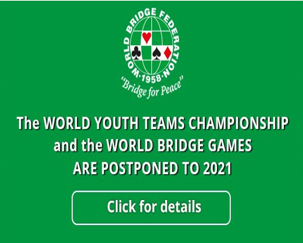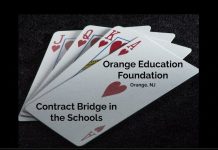| West | North | East | South |
| 1 |
|||
| Pass | 1 |
Pass | 2 |
| Pass | 3 |
Pass | 4 |
| Pass | 5 |
Pass | Pass |
| Pass |
Jump Rebid in a new Suit by Andrew Robson
Source: https://www.andrewrobson.co.uk
Some bids in bridge are complete “sign off’s” – e.g. 1NT-2 . Some are invitational – e.g. 1
. Some are invitational – e.g. 1 -3
-3 , and some force partner to speak again – e.g. 1
, and some force partner to speak again – e.g. 1 -1
-1 . A few bids actually force partner to keep bidding until Game is reached; one such “Game-forcing” sequence is a jump rebid in a new suit by Opener – e.g. 1
. A few bids actually force partner to keep bidding until Game is reached; one such “Game-forcing” sequence is a jump rebid in a new suit by Opener – e.g. 1 -1
-1 -2
-2 or 1
or 1 -1
-1 -3
-3 .
Dealer South N/S Vul
.
Dealer South N/S Vul
South’s jump rebid of 2 was game-forcing and showed at least five
was game-forcing and showed at least five  s and at least four
s and at least four  s. North correctly gave “false preference” back to South’s first suit. South then bid 4
s. North correctly gave “false preference” back to South’s first suit. South then bid 4 to see if his partner could cooperate in a Slam venture. North – still unable to pass as game had not been reached – made the weakest bid by raising to 5
to see if his partner could cooperate in a Slam venture. North – still unable to pass as game had not been reached – made the weakest bid by raising to 5 .
West led
.
West led  5 to East’s
5 to East’s  A and South trumped East’s
A and South trumped East’s  Q continuation. He crossed to dummy’s
Q continuation. He crossed to dummy’s  10, cashed
10, cashed  Q and led
Q and led 5 to
5 to  2,
2,  J and West’s
J and West’s  K. West returned
K. West returned  K and South trumped, drew the last trump, led
K and South trumped, drew the last trump, led  Q overtaking with dummy’s
Q overtaking with dummy’s  A, and led
A, and led  9. East played
9. East played  3, South
3, South  8 and West
8 and West  6.
6.  7 followed to
7 followed to  4 and South’s
4 and South’s  10 won. The rest of his hand was high.
ANDREW’S TIP: A jump rebid in a new suit by Opener is forcing to Game.
10 won. The rest of his hand was high.
ANDREW’S TIP: A jump rebid in a new suit by Opener is forcing to Game.

























